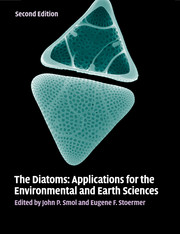Book contents
- Frontmatter
- Contents
- List of contributors
- Preface
- Part I Introduction
- Part II Diatoms as indicators of environmental change in flowing waters and lakes
- 4 Assessing environmental conditions in rivers and streams with diatoms
- 5 Diatoms as indicators of long-term environmental change in rivers, fluvial lakes, and impoundments
- 6 Diatoms as indicators of surface-water acidity
- 7 Diatoms as indicators of lake eutrophication
- 8 Diatoms as indicators of environmental change in shallow lakes
- 9 Diatoms as indicators of water-level change in freshwater lakes
- 10 Diatoms as indicators of hydrologic and climatic change in saline lakes
- 11 Diatoms in ancient lakes
- Part III Diatoms as indicators in Arctic, Antarctic, and alpine lacustrine environments
- Part IV Diatoms as indicators in marine and estuarine environments
- Part V Other applications
- Part VI Conclusions
- Glossary, acronyms, and abbreviations
- Index
- References
5 - Diatoms as indicators of long-term environmental change in rivers, fluvial lakes, and impoundments
from Part II - Diatoms as indicators of environmental change in flowing waters and lakes
Published online by Cambridge University Press: 05 June 2012
- Frontmatter
- Contents
- List of contributors
- Preface
- Part I Introduction
- Part II Diatoms as indicators of environmental change in flowing waters and lakes
- 4 Assessing environmental conditions in rivers and streams with diatoms
- 5 Diatoms as indicators of long-term environmental change in rivers, fluvial lakes, and impoundments
- 6 Diatoms as indicators of surface-water acidity
- 7 Diatoms as indicators of lake eutrophication
- 8 Diatoms as indicators of environmental change in shallow lakes
- 9 Diatoms as indicators of water-level change in freshwater lakes
- 10 Diatoms as indicators of hydrologic and climatic change in saline lakes
- 11 Diatoms in ancient lakes
- Part III Diatoms as indicators in Arctic, Antarctic, and alpine lacustrine environments
- Part IV Diatoms as indicators in marine and estuarine environments
- Part V Other applications
- Part VI Conclusions
- Glossary, acronyms, and abbreviations
- Index
- References
Summary
Introduction
Natural succession of rivers, such as sediment filling, migration, and the development of abandoned river channels into terrestrial systems, tends to occur over geological timescales. In recent centuries rivers have been used as water supplies for domestic, agricultural, and industrial activities, and for navigation, fisheries and water power. These anthropogenic activities have accelerated changes in river systems through pollution, habitat destruction, non-native species introductions, hydrologic manipulation and other physical disturbances. In addition to the obvious physical impairments, human activities have had numerous deleterious impacts on water quality and biotic communities inhabiting rivers (Smol, 2008).
The anthropogenic nutrient and particulate loads carried by rivers have markedly increased over the past few centuries, causing an overall increase in organic matter flux. However, one of the most significant manipulations of rivers has been damming, resulting in impounded aquatic systems that plainly contrast their previous conditions. Dam construction has reduced organic flux in many regions (Meade et al., 1990), and it is estimated that seven times the natural volume of rivers is stored in the world's reservoirs (Vörösmarty et al., 1997). Dams have also changed the global silica cycle by storing large amounts of biogenic silica in reservoir deposits and preventing its delivery to oceans (Humborg et al., 2000). Enhanced diatom productivity fueled by excess nutrients in the world's rivers has further increased the trapping efficiency of silica within impoundments (Triplett et al., 2008).
- Type
- Chapter
- Information
- The DiatomsApplications for the Environmental and Earth Sciences, pp. 86 - 97Publisher: Cambridge University PressPrint publication year: 2010
References
- 6
- Cited by



